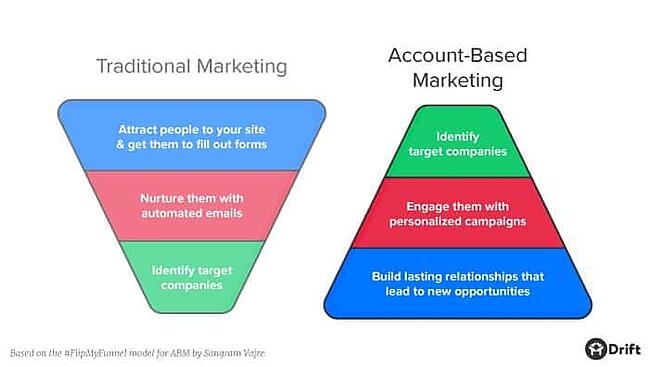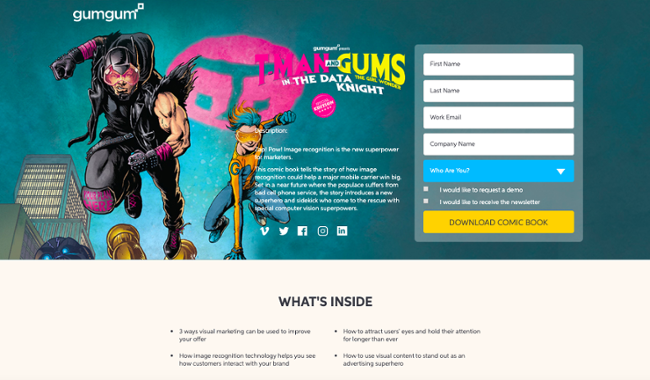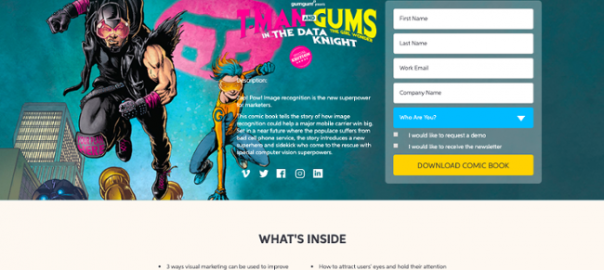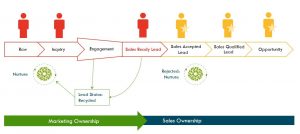Marketing is responsible for lead generation, but casting a wide net for attracting visitors you want to convert can hurt lead quality.
Many companies are getting more targeted in creating content to capture leads, applying an account-based marketing approach.
What Is Account-Based Marketing (ABM)?
The main difference account-based marketing has is the focus on targeting companies at the very beginning of the process. Essentially, this is built around personalization.
Instead of traditional marketing strategies, which often end with good fit companies, you’re starting with targeting companies.

source: Drift
This changes many different aspects of your marketing, as you can imagine. Applying this framework shifts priorities and requires different tactics.
While it’s a big change in how you reach your audience, you can enjoy the many advantages of it.
Benefits of Account-Based Marketing
There are plenty of reasons brands are embracing this approach. Some of the most impactful advantages are as follows:
More Personalized
You’re creating content that speaks directly to decision makers within targeted companies. Building campaigns tailor made for specific individuals is incredibly powerful.
While account-based marketing campaigns won’t cast a wide net and generate a ton of leads for you, when planned and executed correctly, they will resonate with the right people. And that builds an intimate connection that makes your target audience feel seen.
Shorter Sales Cycle
Marketers aim to generate leads in everything they do. But with traditional campaigns, a lot of those leads being handed over won’t close. With this approach, sales is getting more qualified leads.
Touchpoints in ABM are more targeted and contextual, so leads feel valued and understood. Sales won’t be bogged down nearly as much with prospecting a lot of leads who are unlikely to close. They spend less time nurturing the wrong leads, giving them more time to focus on those that will.
Improved Alignment
ABM brings marketing and sales data into alignment. Sales won’t be complaining about their lead quality nearly as much. Plus, they’ll give marketing more insights on customer data, helping them refine their campaigns over time.
This focus on collaboration with customer data helps both teams set realistic expectations and gets everyone on the same page. Marketing will know more about customers as sales closes more deals, which helps the marketing team know exactly how to attract the right leads. And sales will get the leads they want.
Easier to See ROI
Ah, the marketing team’s biggest challenge – attributing revenue to their efforts. It’s hard to associate each campaign with new revenue when you’re using traditional marketing.
However, with ABM, you see exactly who each campaign is targeting. So when those targeted companies eventually start making purchases, your teams can track the results directly to touchpoints within those campaigns that are tailored for specific organizations and decision makers within them.
Yields Stronger Customer Relationships
As with all marketing, you have one main goal with your content – you want your target audience to feel seen and understood so they trust you as a credible resource. When you come across content that is actually helpful, you trust the company that delivered it.
This trust extends into the customer relationship. And by continually delivering helpful content to your customer base, you’re strengthening that relationship. They will see that you truly understand their needs.
Less Wasted Resources
A lot of marketing efforts run the risk of falling short of their associated goals, especially when they’re not properly strategized. With ABM, you’re ensuring each tactic hits a particular person at the right time.
These campaigns are hyper-targeted, so there’s not much being “wasted.” In other words, your marketing team won’t be spending too many resources on initiatives that don’t show some promise of delivering real value to your business.
4 Account-Based Marketing Tactics You Need to Develop Your Strategy
To drive sales with an account-based marketing strategy, you have plenty of tactics at your disposal that you should be using.
1. Built a List of Target Companies.
Marketers understand the value of starting each initiative by defining the target audience. This is why buyer personas are a must for every marketing team.
With ABM, marketing and sales needs to work closely together to define target companies together.
This collaboration calls for sharing customer data based on firmographics (e.g., company size, revenue, etc.) and other factors of the target company’s strategy, like their expected profit margin and how their market influence stacks up in their industry.
Combining quantifiable data with qualitative information is the ultimate approach. You can paint a full picture of what your perfect company looks like. You should compile a list of ideal companies you want as customers.
2. Dive Deeper on Each Target.
The best part about focusing on accounts in your marketing efforts is the fact that you can treat each company like a persona from an organizational level.
Once you have your list of target companies, your team has the information they need to familiarize themselves more with the actual people you’re trying to attract.
Team members can manually research who works in each target company by using tools like LinkedIn. This helps them find key players and decision makers within each target company.
3. Map Out Your Content Strategy.
Once you have your list of people you want to target in each company, you’re ready to develop a content strategy that addresses each of them. But not just from a persona level.
Instead, you want to create content that focuses on single deals you want to make with the organization. A documented content strategy allows you to ensure messaging is consistent for each person within the company. It also helps you define what channels to use in your ABM efforts.
4. Execute, Then Analyze Results.
At this point, you have your content strategy mapped out for each target company. Now, it’s time to put it into action. Just make sure your message is consistent to prevent sending mixed messages to the same person within the target company.
To ensure your execution is actually successful, you need a plan for measuring and evolving it over time. Define your KPIs upfront for each ABM campaign.
These metrics should shed light on how many people within each target company are actually engaging with your brand, how these touchpoints have influenced each individual’s behaviors and actions, and how much revenue is being influenced for these target companies.
3 Account-Based Marketing Examples to Spark Inspiration
Now that you know how to build an ABM strategy and what tactics to use, you can learn from the best of the best. Check out these three examples.
1. Vidyard: Personalized Holiday Campaign
Creating content that is personalized to specific accounts can be time intensive. Templated content can help streamline content production, setting up sales to add a little personalized flair.
Vidyard, one of the best known video hosting platforms, delivered customized videos to companies during the holidays.
They started with a templated video, telling the story of how the main character wanted to express his appreciation to the recipient during the holiday season.
There are many moments in the video where the sales team personalized the video by adding the first name of the recipient.

Source: Vidyard
The content is short, entertaining, humorous, and sincere, which is why their results were so impressive. Their click-through rate was 157 percent higher than industry average.
What’s more, they encouraged recipients to pay it forward by enabling them to customize their own version and send it to their network. This resulted in over 3,500 people creating their own and sharing them.
2. Snowflake: Customized Experiences
Delivering personalized content is not a new concept. You can accomplish this using various approaches, including smart content. The impact of delivering an experience tailored to an account is incredible.
Snowflake, a cloud-based data warehousing company, aimed to accomplish one thing with their one-to-one content experiences – build their credibility with the right audience. Their campaigns were built around personalized display ads that send the user to a dedicated landing page.
The content the user saw was curated specifically for individuals associated with the target account. They run over 500 one-to-one campaigns concurrently.
The results: over 50 percent of the content being consumed on their site is attributed to the personalized ads being run as part of their ABM strategies. Additionally, 50 percent of their content downloads come from the targeted accounts.
3. GumGum: Catered Storytelling
The human touch is a must in all marketing. It builds a relationship based on intimacy. Automation still holds a place in the current marketing and sales landscape, but going that extra mile to have a personal impact on someone is priceless.
GumGum, an applied computer vision company, certainly went above and beyond to earn the attention of a decision maker for T-Mobile, one of their target companies.
To get in front of their CEO, John Legere, the GumGum team did some digging. They found that he was a big fan of Batman. Their tactic: create a customized comic book.

Source: GumGum
The book told the story of T-Man and Gums, and it showcased how image recognition technology could help mobile carriers like T-Mobile. The approach was genius, and the comic book itself is actually very informative, entertaining, and just plain cool.
Most importantly, this ABM tactic ending up influencing the target to close as a customer.
Account-Based Marketing Software Solutions: What to Look For + 6 Options to Consider
ABM is a major shift in the way companies market to their customers. Given all the tips and insights, you’re ready to get started.
Fortunately, there are plenty of incredible account-based marketing software solutions you can choose from.
What to Look for In Your ABM Software
When you’re shopping for a tool that’s right for your ABM needs, there are a few key features you can’t miss out on.
Centralized Data
Marketing, sales, and customer service teams should have complete access to customer data, which is stored in a central repository (like a CRM), so everyone gets the same picture of each target account.
Account-Based Advertising
Your ad functionality should allow for personalization and hyper targeting so you can properly engage decision makers and key players in your display advertising.
Account-Based Report
The analytics tool should include reports and metrics that exist at the account level to allow your teams to optimize campaigns as you gather more performance data.
Real-time Engagement Data
Your team should know about how targets are engaging with your brand in real time so they can immediately prioritize leads and act fast in delivering their tailored messaging.
Top ABM Software Solutions
Pipedrive
As a leading sales CRM, Pipedrive earned a stellar reputation, with a 4.5 out of 5 star rating on Capterra. They’re known for simplicity and usability.
Marketo
Noted as one of the world’s best marketing automation platforms, Marketo offers plenty of ABM capabilities, including AI-powered target account list building and account-level personalization.
Pardot
Another top marketing automation platform, Pardot by Salesforce provides a similar set of ABM functions, such as account-based journey maps. This is especially useful if you’re already using their world-renowned CRM.
Drift
The A player in the conversational marketing game, Drift’s ABM tools are plentiful, empowering your teams to start conversations in real time. One of the best features is the conversation analysis, which allows you to measure team performance in how they’re engaging targeted accounts.
HubSpot
Our favorite business software HubSpot provides a lot of great ABM solutions as well. Thanks to their powerful CRM, all teams can align and build targeted outreach campaigns that hit the right accounts at the right time.
Sigstr
While they’re primarily know for email signature marketing, Sigstr’s ABM programs yield big success stories. Their variety of integrations makes this solution a great addition if you’re using a CRM and other business software.
Once you find the software that fits your budget and aligns with your goals, you’re ready to get your teams together to drive results.
Account-based marketing is more than just a cool new trend. It’s a proven method for taking your efforts to the next level.
Business & Finance Articles on Business 2 Community
(89)
Report Post







